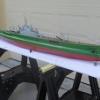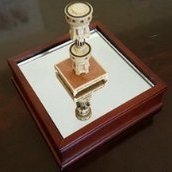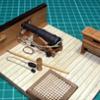-
Posts
4,520 -
Joined
-
Last visited
Reputation Activity
-
 Blue Ensign got a reaction from Piet in SS Kaiser Wilhelm der Grosse 1897 by Mirabell61 - FINISHED - scale 1:144 - POF - first German four stacker of the Norddeutscher Lloyd line
Blue Ensign got a reaction from Piet in SS Kaiser Wilhelm der Grosse 1897 by Mirabell61 - FINISHED - scale 1:144 - POF - first German four stacker of the Norddeutscher Lloyd line
I am awed by the sheer magnificance of this build Nils.
B.E.
-
 Blue Ensign got a reaction from mtaylor in SS Kaiser Wilhelm der Grosse 1897 by Mirabell61 - FINISHED - scale 1:144 - POF - first German four stacker of the Norddeutscher Lloyd line
Blue Ensign got a reaction from mtaylor in SS Kaiser Wilhelm der Grosse 1897 by Mirabell61 - FINISHED - scale 1:144 - POF - first German four stacker of the Norddeutscher Lloyd line
I am awed by the sheer magnificance of this build Nils.
B.E.
-
 Blue Ensign got a reaction from CaptainSteve in Rattlesnake by JSGerson - FINISHED - Mamoli - 1:64 - Using Robert Hunt’s practicum
Blue Ensign got a reaction from CaptainSteve in Rattlesnake by JSGerson - FINISHED - Mamoli - 1:64 - Using Robert Hunt’s practicum
Well done Jon, a fine model, beautifully displayed.
B.E.
-
 Blue Ensign reacted to mtaylor in Licorne 1755 by mtaylor - 3/16" scale - French Frigate - from Hahn plans - Version 2.0 - TERMINATED
Blue Ensign reacted to mtaylor in Licorne 1755 by mtaylor - 3/16" scale - French Frigate - from Hahn plans - Version 2.0 - TERMINATED
Thanks for the comments and the "likes".
Life and other things continues to take my shipyard time.....
So.. some replies first, update next.
Eric,
I was tech writer for 25 years in a previous life (the one before I went into IT work)... I still get caught on such stuff.
I did some manuals in my previous life for equipment used by the Brits. I had to learn a whole new language for them. I believe (and am probably wrong) that it was Winston Churchill who said "We're two countries, separated by a common language".
After sorting out how the deck was planked by referencing other French frigates as much as I could, used the cross-section drawing as my baseline. Licorne is definitely an oddball in this regard. The references show the traditional planking that follows the waterway and tapers. Some use nibbing at the bow, some use hook scarfs. Others... nada. Towards the stern... there's where I ran into headaches. Some use drop planks, some don't. Some have parquet floors in the great cabin. Some don't.
So.. decision time. I went with the spirit of the beast. No drop planks, no scarfs or nibbing at the bow, There's two wide planks thicker than the rest at the waterway.. much like binding strakes. Then theres 3 stakes of "normal planks", a very wide binding strake, and 5 "normal planks. None of the works showed hook scarfs in the binding strakes like the English used.. So.. I'm going with what I have.
I began by doing a reference drawing (actually reworking what I had done already) with actual dimensions to account for errors in building with respect to width of the area to be planked and beam placement. I then added tic marks along the centerline of each beam for the plankwidth starting at the 0 station line (dead flat, widest point) and scaled them to both the stern and the bow. Next came drawing in the planks. The cutting part was the easy part and am now installing the aft planking first.
The first picture shows the result of this work in the great cabin aft of the mizzen mast. The drawings and cuttings were tweaked to account for the kerf of the laser. Also, the planking that showing is actually the bottom side of the sheet. Given the way the kerf is, this provided a natural beveling. I lightly sanded the char but didn't remove all of it as a) there's little glue used on the edge of the plank and it gives a nice (to my eye) simulation of caulking. There's also another plank laying on the beams ready for installation.
The second photo merely shows the planks cut and still held in place in the sheet stock. These planks are from where the existing planking is to the waterway. I left a bit of extra meat on the outside plank goes by the waterway for fitting.
I'm having a lot of fun with this once I figure out what needs to be done. The "how" is just as important as the "what" in this case. Frustrating at times, but very satisfying when it comes together.
As always, feel free to point out errors, misadventures, etc. This is pretty much virgin territory for me...
-
 Blue Ensign reacted to Mirabell61 in SS Kaiser Wilhelm der Grosse 1897 by Mirabell61 - FINISHED - scale 1:144 - POF - first German four stacker of the Norddeutscher Lloyd line
Blue Ensign reacted to Mirabell61 in SS Kaiser Wilhelm der Grosse 1897 by Mirabell61 - FINISHED - scale 1:144 - POF - first German four stacker of the Norddeutscher Lloyd line
UPDATE
made some structures and 24 windows, and the first two funnel (raw) sections. The appropriate vents still have to be placed, as well as the quater for the first officer.
Nils
a little paint and gratings on the middle upper structures. The sockets are ready to take up the funnel tubes with 10° backward rake
dry fit of the first two funnels
diagonal its possible to get the total overview on the pic
-
 Blue Ensign reacted to rafine in Granado by rafine - FINISHED - Caldercraft - 1:64
Blue Ensign reacted to rafine in Granado by rafine - FINISHED - Caldercraft - 1:64
This past week, I made up and rigged the wingsail gaff and the topmast yard. I also did the spritsail yard braces.
The wingsail gaff is a dowel, tapered at both ends, and using the kit jaws. The parrel is beads strung on a piece of wire inserted into the jaws. I added paper bands and an eyebolt and painted the gaff black. The gaff was then mounted and rigged, doing the peak and throat halyards and the vangs.
The topsail yard was made up like the main yard, using a dowel filed square in it's center section, then built up with strip and filed eight sided. The ends were tapered, the various cleats added, and the yard painted black. Before mounting, I added the foot ropes and stirrups, the blocks for the tie, the lifts/topgallant sheets, the clews and the braces. I also made up and added the parrel, done like the main yard with beads and strip wood ribs. The yard was mounted and partially rigged, doing the tie and it's double falls, and the topsail clews and sheets.
For the spritsail braces, I ran the running parts through blocks on a short span attached to the main preventer stay. These are shown in Lees and the kit plans, bur not in AOTS.
I will next finish up the mainmast with the topgallant yard and then move on to the mizzen.
Bob
-
 Blue Ensign got a reaction from druxey in Deadeyes versus Hearts for Standing Rigging
Blue Ensign got a reaction from druxey in Deadeyes versus Hearts for Standing Rigging
I tend to use 0.1mm diameter line for serving, but if I think the true scale size of the line to be served would look too bulky, I reduce the size of the line to be served to allow for this. How it fits around any scale heart or block also has to be taken into account, sometimes compromises are required to get the right effect.
You should start a build log, don't think there are any other examples of Liverpool on here.
Cheers,
B.E.
-
 Blue Ensign got a reaction from druxey in Deadeyes versus Hearts for Standing Rigging
Blue Ensign got a reaction from druxey in Deadeyes versus Hearts for Standing Rigging
Hi Tom, I would be inclined to use hearts at that date.
My reading of Lees (page 40) is that deadeyes were used for the lower stays up to 1690, and hearts thereafter.
Steel's description is:
THE FORE-STAY has a heart turned in the lower end with a throat-seizing, and two round seizings above, and the end of the stay capped with canvas, whipped and tarred, then set up with a laniard, that reeves alternately through the heart in the stay and the heart in the fore-stay-collar on the bowsprit. The first four turns lie in scores cut in the hearts, and are tallowed, that the strain may be immediately given to all the turns at once. The laniard is then strained tight by tackles, thus: The upper block of a luff-tackle is hooked to a selvagee fastened round the stay, and the lower block is hooked with a cats-paw to the laniard: then the outer-block of another luff-tackle is hooked with a cats-paw to the fall of the other tackle, and the inner block hooked where most convenient. The fall leads in upon deck, and is swayed by all hands. Then two of the turns, are stopt together with a rope-yarn to prevent their coming up, and more turns taken, and hove on, as before, till the laniard is expended; the end is then well stopped.
THE PREVENTER-STAY is set up the same as the fore-stay.
THE MAIN-STAY sets up, as the fore-stay, to a heart seized in the bight of the main-stay-collar above the bowsprit-chock.
Steel does make reference to the use of deadeyes as an alternative to hearts for the Bobstays and Bowsprit shrouds.
Regards,
B.E.
-
 Blue Ensign got a reaction from mtaylor in Deadeyes versus Hearts for Standing Rigging
Blue Ensign got a reaction from mtaylor in Deadeyes versus Hearts for Standing Rigging
I tend to use 0.1mm diameter line for serving, but if I think the true scale size of the line to be served would look too bulky, I reduce the size of the line to be served to allow for this. How it fits around any scale heart or block also has to be taken into account, sometimes compromises are required to get the right effect.
You should start a build log, don't think there are any other examples of Liverpool on here.
Cheers,
B.E.
-
 Blue Ensign got a reaction from md1400cs in Deadeyes versus Hearts for Standing Rigging
Blue Ensign got a reaction from md1400cs in Deadeyes versus Hearts for Standing Rigging
Tom, this is a link to the online version of Steel's The Elements and Practice of Rigging And Seamanship, 1794,
http://www.hnsa.org/resources/manuals-documents/age-of-sail/the-elements-and-practice-of-rigging-and-seamanship/
Hope you find it useful.
B.E.
-
 Blue Ensign got a reaction from mtaylor in Deadeyes versus Hearts for Standing Rigging
Blue Ensign got a reaction from mtaylor in Deadeyes versus Hearts for Standing Rigging
Tom, this is a link to the online version of Steel's The Elements and Practice of Rigging And Seamanship, 1794,
http://www.hnsa.org/resources/manuals-documents/age-of-sail/the-elements-and-practice-of-rigging-and-seamanship/
Hope you find it useful.
B.E.
-
 Blue Ensign got a reaction from mtaylor in Deadeyes versus Hearts for Standing Rigging
Blue Ensign got a reaction from mtaylor in Deadeyes versus Hearts for Standing Rigging
Hi Tom, I would be inclined to use hearts at that date.
My reading of Lees (page 40) is that deadeyes were used for the lower stays up to 1690, and hearts thereafter.
Steel's description is:
THE FORE-STAY has a heart turned in the lower end with a throat-seizing, and two round seizings above, and the end of the stay capped with canvas, whipped and tarred, then set up with a laniard, that reeves alternately through the heart in the stay and the heart in the fore-stay-collar on the bowsprit. The first four turns lie in scores cut in the hearts, and are tallowed, that the strain may be immediately given to all the turns at once. The laniard is then strained tight by tackles, thus: The upper block of a luff-tackle is hooked to a selvagee fastened round the stay, and the lower block is hooked with a cats-paw to the laniard: then the outer-block of another luff-tackle is hooked with a cats-paw to the fall of the other tackle, and the inner block hooked where most convenient. The fall leads in upon deck, and is swayed by all hands. Then two of the turns, are stopt together with a rope-yarn to prevent their coming up, and more turns taken, and hove on, as before, till the laniard is expended; the end is then well stopped.
THE PREVENTER-STAY is set up the same as the fore-stay.
THE MAIN-STAY sets up, as the fore-stay, to a heart seized in the bight of the main-stay-collar above the bowsprit-chock.
Steel does make reference to the use of deadeyes as an alternative to hearts for the Bobstays and Bowsprit shrouds.
Regards,
B.E.
-
 Blue Ensign got a reaction from mtaylor in Attachment of Ratlines to shrouds
Blue Ensign got a reaction from mtaylor in Attachment of Ratlines to shrouds
I did find a painting by Robert Cleveley who was an eye witness at the time of the war, and served aboard the Asia as Clerk to the Captain.
His painting The Occupation of Newport appears to show the British ships wearing the White Ensign.
Here's the link.
https://www.google.co.uk/search?q=The+invasion+of+Rhode+Island+1776&hl=en&biw=1344&bih=720&site=webhp&tbm=isch&imgil=Z2s-ScLsU8jJBM%253A%253BcbZkZQl7q4-2JM%253Bhttps%25253A%25252F%25252Fen.wikipedia.org%25252Fwiki%25252FBattle_of_Rhode_Island&source=iu&pf=m&fir=Z2s-ScLsU8jJBM%253A%252CcbZkZQl7q4-2JM%252C_&usg=__31uR3SrjjSHMASyy1AWWM1HDLlw%3D&ved=0ahUKEwjF_8P10IrSAhXlKcAKHUvkCQMQyjcIPQ&ei=z16gWIXcG-XTgAbLyKcY#imgrc=ZROkdfV977raoM:
There is a colour print of this painting on the cover of a book I have called Navies and the American Revolution 1775 - 1783 (Chatham Pictorial Histories)
and the painting clearly shows a White Ensign on the ships right and centre.
ps: you will find many photo's of my Pegasus build on my log - click on the link below my name.
Cheers,
B.E.
-
 Blue Ensign got a reaction from mtaylor in HMS Victory by dafi - Heller - PLASTIC - To Victory and beyond ...
Blue Ensign got a reaction from mtaylor in HMS Victory by dafi - Heller - PLASTIC - To Victory and beyond ...
Wonderful concept Daniel, and a great result at only 1:100 scale
Great stuff.
M.
-
 Blue Ensign got a reaction from thibaultron in Attachment of Ratlines to shrouds
Blue Ensign got a reaction from thibaultron in Attachment of Ratlines to shrouds
Ensigns can be a tricky issue Tom.
At the time Liverpool was serving in the American Station Vice Admiral Richard Howe was in Command. It would follow but not exclusively that ships of his squadron would wear his colours. The question is was Lord Howe, Vice Admiral of the Red, White, or Blue? I'm not sure, and the info I have doesn't mention this fact.
If you can find some contemporary paintings of the naval engagements around 1778 this may show the Ensign colours.
I don't think anyone would gainsay you whatever Ensign colour you use provided it isn't the 1801 version.
I will be using the Red Ensign on my Pegasus, which was heading for Newfoundland when she was lost in 1777.
Regards,
B.E.
-
 Blue Ensign got a reaction from thibaultron in Attachment of Ratlines to shrouds
Blue Ensign got a reaction from thibaultron in Attachment of Ratlines to shrouds
Hi Tom, are we talking about HMS Liverpool 1758-1778, 28 gun Coventry Class 6th Rate?
B.E.
-
 Blue Ensign got a reaction from mtaylor in SS Kaiser Wilhelm der Grosse 1897 by Mirabell61 - FINISHED - scale 1:144 - POF - first German four stacker of the Norddeutscher Lloyd line
Blue Ensign got a reaction from mtaylor in SS Kaiser Wilhelm der Grosse 1897 by Mirabell61 - FINISHED - scale 1:144 - POF - first German four stacker of the Norddeutscher Lloyd line
Wonderful stuff Nils, just love that shot showing her in all her magnificence
B.E.
-
 Blue Ensign got a reaction from mtaylor in Attachment of Ratlines to shrouds
Blue Ensign got a reaction from mtaylor in Attachment of Ratlines to shrouds
Ensigns can be a tricky issue Tom.
At the time Liverpool was serving in the American Station Vice Admiral Richard Howe was in Command. It would follow but not exclusively that ships of his squadron would wear his colours. The question is was Lord Howe, Vice Admiral of the Red, White, or Blue? I'm not sure, and the info I have doesn't mention this fact.
If you can find some contemporary paintings of the naval engagements around 1778 this may show the Ensign colours.
I don't think anyone would gainsay you whatever Ensign colour you use provided it isn't the 1801 version.
I will be using the Red Ensign on my Pegasus, which was heading for Newfoundland when she was lost in 1777.
Regards,
B.E.
-
 Blue Ensign got a reaction from mtaylor in Attachment of Ratlines to shrouds
Blue Ensign got a reaction from mtaylor in Attachment of Ratlines to shrouds
Hi Tom, are we talking about HMS Liverpool 1758-1778, 28 gun Coventry Class 6th Rate?
B.E.
-
 Blue Ensign got a reaction from mtaylor in Attachment of Ratlines to shrouds
Blue Ensign got a reaction from mtaylor in Attachment of Ratlines to shrouds
I have not used that method but it seems very tortuous to me. At 1:96 scale the line should be at 0.1mm diameter, and have a clear differential to the shroud line.
My approach would be to trial both a clove hitch and a simple overhand knot and choose which I thought looked the best. It may be that at 1:96 scale the overhand knot may look neater.
I tend to use the overhand knot at smaller scales, it is my preferred method of choice for scales down to around 1:150
B.E.
-
 Blue Ensign got a reaction from thibaultron in Attachment of Ratlines to shrouds
Blue Ensign got a reaction from thibaultron in Attachment of Ratlines to shrouds
I have not used that method but it seems very tortuous to me. At 1:96 scale the line should be at 0.1mm diameter, and have a clear differential to the shroud line.
My approach would be to trial both a clove hitch and a simple overhand knot and choose which I thought looked the best. It may be that at 1:96 scale the overhand knot may look neater.
I tend to use the overhand knot at smaller scales, it is my preferred method of choice for scales down to around 1:150
B.E.
-
 Blue Ensign got a reaction from Nirvana in USF Confederacy by Augie & Moonbug - FINISHED - Model Shipways - 1:64
Blue Ensign got a reaction from Nirvana in USF Confederacy by Augie & Moonbug - FINISHED - Model Shipways - 1:64
All looking good, neat idea to modify the mast rings.
B.E.
-
 Blue Ensign got a reaction from Piet in SS Kaiser Wilhelm der Grosse 1897 by Mirabell61 - FINISHED - scale 1:144 - POF - first German four stacker of the Norddeutscher Lloyd line
Blue Ensign got a reaction from Piet in SS Kaiser Wilhelm der Grosse 1897 by Mirabell61 - FINISHED - scale 1:144 - POF - first German four stacker of the Norddeutscher Lloyd line
Wonderful stuff Nils, just love that shot showing her in all her magnificence
B.E.
-
 Blue Ensign got a reaction from FriedClams in SS Kaiser Wilhelm der Grosse 1897 by Mirabell61 - FINISHED - scale 1:144 - POF - first German four stacker of the Norddeutscher Lloyd line
Blue Ensign got a reaction from FriedClams in SS Kaiser Wilhelm der Grosse 1897 by Mirabell61 - FINISHED - scale 1:144 - POF - first German four stacker of the Norddeutscher Lloyd line
Wonderful stuff Nils, just love that shot showing her in all her magnificence
B.E.
-
 Blue Ensign got a reaction from BANYAN in HMB Endeavour by shipaholic - FINISHED - Eaglemoss - 1/51
Blue Ensign got a reaction from BANYAN in HMB Endeavour by shipaholic - FINISHED - Eaglemoss - 1/51
I seem to have missed this log, what a fine job you are making of her Steve, a great looking model.
ps: I quite like a degree of uniform sag in the large stays, think it gives an impression of 'weightiness', it's something I try and manufacture
Regards,
B.E.









